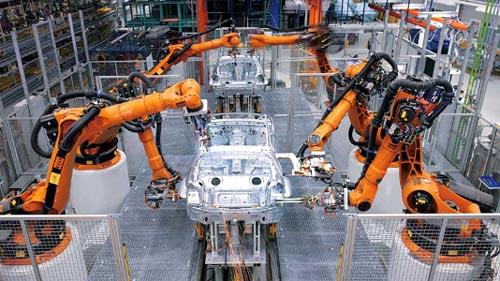Reinhard Haider of the Upper Austria Chamber of Labour examines the labour market effects of digitalisation and the blurring of boundaries between work and private life. He argues that increased digitalisation and automation will significantly change and affect both the quality and quantity of jobs. New forms of jobs and employment in turn are affecting working conditions by altering skills requirements and also changing patterns of work.
New technologies are relevant factors concerning the ongoing changes in the labour market. Some studies emphasize the disruptive nature of technological change by stressing the potentially wide-ranging implications of job destruction – the hypothesis being that low-skilled labour will be replaced by algorythms and machinery. Evaluations of the extent of the impact of digitalisation on the labour market range from a low of less than 10 percent of all jobs to a high of more than 60 percent.
It is prudent to ask is whether horror scenarios, where nearly 47 percent of US jobs are susceptible to potential technological replacement or conclusions where digitalisation creates further jobs are true. The very well known and frequently cited study from Frey and Osborne (2013) tends to overestimate the potential adverse effects of digitalisation processes by focusing exclusively on the technical feasibility of substituting labour by automation.
Technology and jobs – How does this affect occupation?
A study from the Austrian Institute for Advanced Studies, published in 2017, estimates job losses due to digitalisation in Austria in the next decades and concludes that 9 percent (360.000 jobs) are at risk in the medium term. Around two-thirds of jobs are at risk in low-skilled occupations. A higher level of education protects occupations from automation because the proportion of automatable tasks is lower in comparison to standard and routine tasks in low-skilled occupations. Another Austrian study from the union of private employees (GPA-djp, 2017) researchers conducted a long-time period labour market comparison in the years between 1995 to 2015.
In sectors with a higher proportion of digitalisation, data collected during this period, 390.000 jobs were created and 75.000 were lost. In sectors with a lower proportion of digitalisation 189.000 jobs were created and 280.000 were lost. This study shows a positive correlation between employment and job creation on the one hand and digitalisation on the other hand and draws a much more unemotional picture of the job losses while not only focusing on the dystopian scenarios.
“Our brains do not have a moment’s rest. They are constantly having to process information, jump from one thing to another and decipher images. Yet people need rest in order to be able to come up with ideas and be creative.” (Joke Hermsen, Dutch philosopher).
From the perspective of labour unions as well as the Austrian Chamber of Labour, it is important to focus on the impacts of transformation of work and how we have to adapt our social security systems in a manner to protect employees form precarity. Another important factor is how we have to modernize our education system to make citizens ready to face the challenges the New World of Work is bringing with it.
Boundless Working Life and Risks of New Ways of Work
Work without boundaries is a “metaphor for work that is not restricted by traditional organizational rules like regular office hours, a single workplace, fixed procedures, and limited responsibility. (…) Because of its strong intuitive meaning and relevance in the changing landscape of work, it found its way into the public. (…) It has become a common way of describing a work situation that escapes any attempts to restrain or even control it. It describes, in other words, a work situation that runs the risk of getting out of hand, of becoming overpowering!” (Alvin, Aronson, Hagström, Johansson, Lundberg (2011): Work without boundaries)
New information and communications technologies (ICT) have revolutionised everyday work and life in the 21st century. One of the main forces driving the rise of New Ways of Work has been the revolutionary increase in all kinds of mobile technologies and communication media, particularly smartphones and tablets. In the EU 28, approx. 17 percent of employees are in Telework/ICT work, in Austria the number is 20 percent according to the Eurofound-Study “Working anytime, anywhere: The effects on the world of work”.
One of the main findings of this study was that T/ICTM workers tend to work longer hours than average employees and this leads to an extension of total working hours and to further blurring the boundaries between work and private spheres. One major reason for this development is the increased availability of employees for work carried out outside normal working hours. In Finland, for instance, 65 percent of teleworkers reported that they had been contacted about work-related matters outside normal working hours in 2013, mostly via email.
A further finding of this study was that ICT use may intensify the pace of work which leads to greater employee stress and burnout. This can have negative implications for overall stress levels and their relationship to the space and time discretion and work occupying non-working spaces and times.
The benefits on the one hand are obvious, modern ICTs offer better and quicker access to information for work – information is accessible anytime and anywhere and also enables a more rapid response to questions from clients, colleagues and managers. The drawbacks on the other hand are also clear. Home- and mobile-working can blur the division between work and private life, oftentimes at the cost of private time. The opportunities of new ways and forms of working are a considerable source of psychosocial occupational stress. If we observe the development of sickness absence days and absences due to mental health problems we see a rapid increase in this field, not only in Austria, but also in many other European countries.
According to the Austrian Work Climate Index (2017),
- About 20 percent of work is boundless – a growing number.
- 25 percent of workers are not able to regenerate fully during their holidays.
- Every fourth worker is permanently accessible for the company.
- 14 percent are checking and answering regularly their official mails and are calling their customers and colleagues.
- Every fifth is not able to mentally disconnect with his/her company during holidays.
- Every sixth respondent has to interrupt his/her holiday.
Psycho social risks are one of the biggest health and safety challenges workers are currently facing across all economic sectors. Digitalisation and Industry 4.0 industrial cycles are fundamentally transforming the organisation of work, its characteristics and its level of flexibility. This entails major changes in tasks fulfilled by employees and how they fulfil them, work autonomy, deadlines and performance pressure, customer demands, communication of appreciation and praise for work done; and last but not least it affects the boundaries between working and private life.
A lot of work remains for unions and the Chamber of Labour: These are big challenges for our institutions to find new ways of supporting and advocating for employees and members!
Reinhard Haider is a Scientific Assistant at the Chamber of Labour (Upper Austria) in the Departement of Working Conditions. His work-related topics are: Digitalisation, sick leave and presenteeism, conflicts and bullying at work where he also consults employees.
His blogposts can be found at: https://awblog.at/author/reinihaider/




